
Why Bohol?
- Nature
- White sand beaches
- Chill vibe
- Ancient geological features
- Unique endemic wildlife
- Historical buildings
- Supports ecotourism
In this article:
1. Panglao Island
2. Danao Eco-Adventure Park
3. Loboc River Cruise
4. Historical Churches
5. Man-Made Forest
6. Tarsier Sancturary
7. The Chocolate Hills
Responsible Tourism
In a nation of over 7,600 islands, Bohol is the tenth largest and one of the most popular with local and international tourists. Like a magnet in the middle of Central Visayas, Bohol’s white sandy beaches, brown Chocolate Hills and unique wildlife continue to attract crowds of tourists each year.
After Bohol’s natural beauty, the crucial element that ensures tourists visit and locals thrive is the region’s commendable commitment to eco-friendly practices and environmental protection. Without the serious implementation of this commitment, Bohol would not have the unspoiled vistas and preserved ancient formations it has to display today.
Bohol’s commitment to developing the region through ecotourism (rather than traditional unconscious development that destroys the environment in the name of progress) goes back decades. In 1997, the Bohol Environment Summit was first held. It laid the groundwork for developing mechanisms that are environmentally sustainable, economically viable, socially equitable and that accelerate development for the benefit of local communities. The vision of the Bohol Ecotourism Development Program is to make Bohol: “a prime eco-cultural tourist destination and a strong agro-industrial province.”
While there’s a huge list of things to see and do in Bohol and its surrounding small islands, we’ll cover 7 activities and sights that we feel are must-dos for tourists who are perhaps new to Bohol and (as is the nature of travelling) limited on time.
-
Panglao Island
One of 75 minor islands in Bohol province, Panglao is most famous for its sandy white beaches and majestic caves.
Relax under the warm Philippine sun in the many bars and family-run restaurants right by the beach. Alihahailey Reggae Bar on Alona Beach is a favourite of ours. Cold beers, reggae beats, chill vibe, waves lapping metres away – what could be better? See our Oslob blog for more.
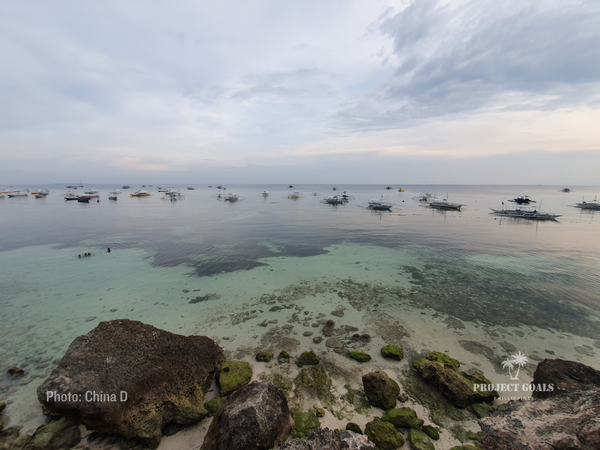
Now that you’re in the island mood, you can explore more of Panglao’s natural wonders.The maribojoc and coralline limestone that Panglao Island is made of has created many underground caves. However, there is one cave that stands out from the rest and is perhaps the best in the Philippines – Hinagdanan Cave.
If you’re into natural geological formations like stalagmites and stalactites, Hinagdanan Cave has many impressive ones for you. But, what makes Hinagdanan Cave particularly stunning is the many zenithal openings (overhead holes to you and me) that allow light to enter and naturally illuminate the otherwise unseen beauty of the underground.
The limestone which dissolved away to form this cave over millennia has allowed a natural lagoon to form. The iridescent green colour is due to the green limestone underneath. There is even wildlife to be found here with swallows using small holes, nooks and crannies as nests.
While tourists can swim in the lagoon (for an extra fee syempre), we wouldn’t encourage it due to contamination from the karst runoff.
Location: JRG2+496, Bingag, Dauis, Bohol, Philippines
Cost: the entrance fee is 50 pesos (90 cents). If you want to swim in the karst-contaminated lagoon, it’ll be an extra 75 pesos (US$1.35).
-
Danao Eco-Adventure Park
Just north of the centre of Bohol, amongst tall trees pushing up through lush green vegetation and sheer cliff faces, is Danao Eco-Adventure Park.
The park is well known for having the tallest, longest zipline in the Philippines, affectionately known as the sui-slide. But forget I said that last bit. It’s actually a lot of fun. As long as you’re ok with heights, it’s not scary, just completely thrilling. There’s something about gliding through the air at 60 km an hour, 480 metres from the ground, hurtling towards a platform with no sign of slowing down until the very last second that just leaves an adrenaline-induced smile on your face. It certainly helps that your journey through the air is accompanied by incredible views that are usually reserved for birds.
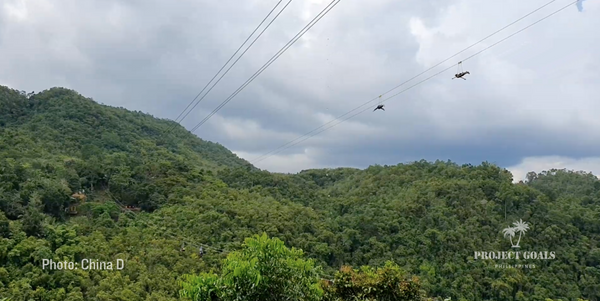
However, it’s not just thrill-seekers that find joy at Danao Eco-Adventure Park (although there’s also the Plunge, cable cars and repelling to try). There are other environmentally and culturally minded activities offered. There’s the Educational Adventure Tour which concentrates on the community’s cultural heritage and preservation efforts, including organic farming methods. The Ecological Adventure Tour allows tourists to more fully immerse themselves and understand the surrounding nature through bird watching, kayaking and viewing the on-site organic farm.
Location: X55H+4HP, Buenavista-Carmen-Danao-Jetafe Road, Danao, 6344 Bohol, Philippines.
Cost: Entrance is 25 pesos (45 cents) per person. The Sui-slide is 350 pesos (US$6.25) per ride.
-
Loboc River Cruise
Known as one of the cleanest rivers in the Philippines, the Loboc River is a highlight in any Bohol itinerary. The award-winning body of water is impressive in both its size and natural beauty. Stretching for 20 km from Bohol’s geographical centre in Carmen, it winds through thick tropical forests before dispersing out into the Bohol Sea in the south.
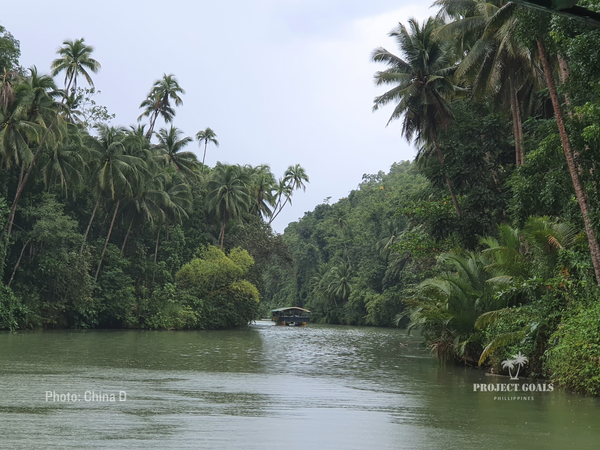
Enjoying a cruise down the Loboc River is a must for anyone visiting Bohol. Firstly, there’s nowhere else in the world where you can ride a hand-crafted boat that looks like a giant floating kubo. And if banks with countless coconut trees stretching over a jade-green river weren’t enough to make a memorable cruise, the boat also makes a stop where locals will display the Binislakan, a native folk dance performed with long bamboo sticks or bislak. If you don’t mind trying new things in front of a bunch of strangers where one false move could sting like crazy, you’re in luck. After the experts are finished, tourists can join in and perform the Binislakan at a safe pace.

To make this experience truly sulit, a buffet lunch is included in the price of the ticket. Plus, in true Philippine style, a live band accompanies the cruise.
Tickets for the cruise can be purchased at the Loboc Tourism Complex.
Location: J2PH+5WH, Loboc, Bohol, Philippines
Cost: 850 pesos (US$15) per person, including buffet lunch, live band and cultural performance.
-
Historic Churches
Although a small island, it seems Bohol always had room for a church. However, these ecclesiastical buildings aren’t any old pile of bricks. Of the 128 churches in the Philippines recognised as National Cultural Treasures, 21 are in Bohol. You could easily spend your entire time in Bohol church crawling, seeing structures spanning the length of modern Philippine history, from the Spanish occupation to the Philippine Revolution to WWII and after. For those on a time budget, here are some of the best:
Baclayon Church
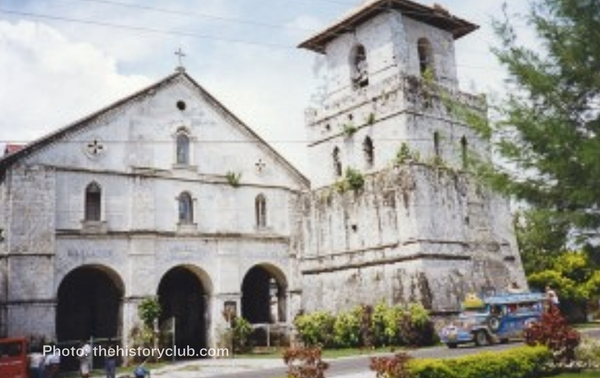
Baclayon Church (also known as La Purisima Concepcion de la Virgen Maria Parish Church) is your classic Spanish-era Philippine church, built using coral stones and hard labour. Founded by the Jesuit priests Juan de Torres and Gabriel Sánchez in 1596, Baclayon is the oldest church settlement in Bohol. Having been passed through the hands of Augustinian Recollects in the 18th century, surviving the American invasion of the late 19th century and WWII in the 20th century, Baclayon Church was declared a National Cultural Treasure by the National Museum of the Philippines in 2010.
Location: JWF6+4XW, Baclayon, Bohol, Philippines
Entry Fee: Free
Loboc Church

Another Spanish-era, coral stone structure completed in 1734, Loboc Church (also known as San Pedro Apostol Parish Church) stands by the Loboc River in just the second area to be settled by Christians. Although it has seen many renovations in its time, including extensive restorations after the devastating 2013 earthquake, its original design remains. In fact, its many facelifts make it a living representation of modern Philippine history.
Location: J2PJ+H97, Loboc, Bohol, Philippines
Entry Fee: Free
Tagbilaran Catherdral

Tagbilaran Cathedral (Church of Saint Joseph the Worker) stands as an enduring symbol of faith and heritage in Bohol. Constructed in 1767 by Spanish Jesuits, this majestic Baroque-style church boasts intricate architectural details, including ornate facades and delicate frescoes. Its bell tower, rising gracefully into the sky, attracts both worshippers and tourists alike. Stepping inside, visitors are transported in time and atmosphere, with light filtering through stained glass windows casting a soft glow over the interior. Tagbilaran Cathedral serves not only as a place of worship but also as a cultural treasure, preserving the rich history and traditions of the region.
Location: JVQ4+X74, Bohol Circumferential Rd, Tagbilaran City, Bohol, Philippines
Entrance Fee: Free
Panglao Church

Panglao Church, officially named the Church of San Agustin, is a cherished landmark on the island of Panglao. Built during the Spanish colonial era in the 18th century, its construction was completed after the Philippine Revolution which saw its creators finally banished from the archipelago. This charming church displays a blend of Baroque and Neo-classical architectural styles - its pristine white facade, adorned with intricate carvings and embellishments, exudes an elegance of a craft perhaps lost to history. The interior, lit by natural light streaming through arched windows, creates an ambience perfect for reflection and prayer. Surrounded by lush tropical greenery, Panglao Church serves as a man-made spiritual oasis amidst the stunning natural beauty of the island, inviting visitors to experience both its religious significance and historical charm.
Location: HPHW+7CF, Bingag, Panglao, Bohol, Philippines
Entry Fee: Free
-
Man-Made Forest
The Bilar Man-Made Forest is a perfect example of the environmental preservation initiatives that have come to represent Bohol. This colossal collaboration with nature was initiated by the Philippine government over 50 years ago to address the area’s deforestation, erosion and soil degradation issues. The result is a 2km stretch of mahogany trees that are so tall and dense, they have created a micro-climate of their own. Affectionately known as the “dark side” of Bohol because of the shade these 20-metre-tall trees create, it feels cool beneath the canopy despite any smouldering rays being cast from the Philippine sun above.
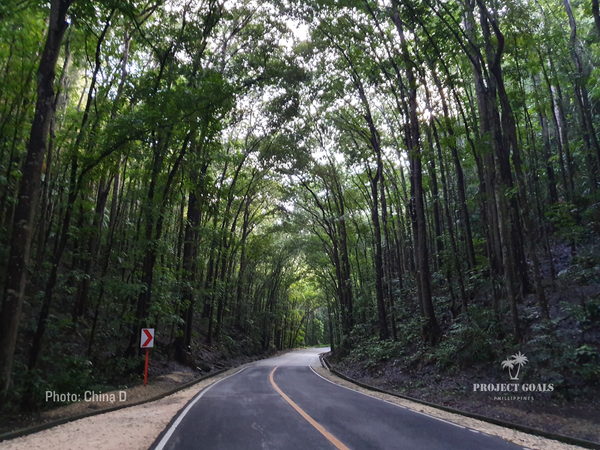
Regardless of the introduced trees, the forest has well and truly assimilated itself and hosts many different species of flora and fauna native to the Philippines. Of course, the optimal way is always to protect and preserve what Mother Nature has already bestowed us with – and we (individuals and government entities) should make every effort to do so through mindful interaction with our natural spaces. However, if the damage has already been done, the next best thing is projects such as this successfully implemented Bilar Man-Made Forest. Located between Bilar and Loboc, the Man-Made Forest is well worth a visit.
-
Tarsier Sanctuary
The Tarsier is a unique animal endemic to the Philippines. Although commonly placed in the suborder Haplorrhini (the same as apes, monkeys and humans), it is believed by some scientists to be a line of primates belonging to no other. As such, every effort has been made by the Tarsier Sanctuary in Bohol to protect these tiny, wide-eyed creatures from extinction.
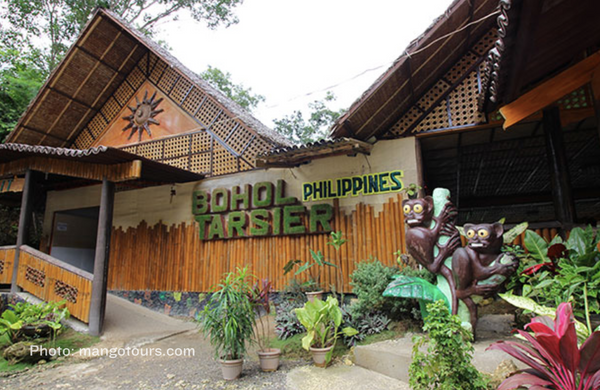
Giving the Tarsier a second chance, it’s perhaps apt that the sanctuary is itself located in a secondary-growth forest in the barangay of Corella. In line with the local government’s ecotourism development plan, the Tarsier Sanctuary aims to:
1. Protect the Philippine Tarsier and its habitat from extinction through increased environmental awareness, research programs and the establishment of protected areas for wildlife in the Province of Bohol.
2. Provide economic and social development opportunities to the local population through the introduction of ecotourism-related livelihood endeavours.
Tourists can walk along a track that winds its way through the sanctuary where they are guaranteed to spot a Tarsier clinging tightly to a woody vine with its elegantly long, bony hands. Although the Tarsier can leap using its relatively long legs, it’s more likely to regard you with its huge eyes, like it’s in complete shock to see a human.

This popular tourist attraction also has a visitor’s complex with an exhibition area, cafeteria, audiovisual room and research centre full of tarsier-related information.
-
The Chocolate Hills
The Chocolate Hills are a geological wonder and one of the most iconic natural attractions in the Philippines. Consisting of approximately 1,200 cone-shaped hills spread across an area of more than 50 square kilometres, these hills are covered in lush green grass that turns brown during the dry season, resembling giant chocolate kisses or - Chocolate Hills.

The exact formation process of the Chocolate Hills remains a subject of scientific debate, with theories ranging from uplifted coral deposits to erosion and weathering. Regardless of their origin, the Chocolate Hills offer breathtaking panoramic views, especially from observation points like the Chocolate Hills Complex or Sagbayan Peak.
Designated as a National Geological Monument and included in the UNESCO tentative list of World Heritage Sites, the Chocolate Hills are a must-visit destination for nature lovers and adventurers alike.
Location: Chocolate Hills Complex, Q5X9+C3V, Carmen, Bohol, Philippines.
Sagbayan Peak, W3GF+3P8, Bacani Road, Carmen, Sagbayan, Bohol, Philippines.
Map of locations:
Controversy
Despite being protected under the Department of Environmental and Natural Resources (DENR), the local Bohol Environmental Management Office (BEMO) and the Bohol Tourism Office (BTO), part of the Chocolate Hills were inconsiderately and irrevocably damaged by the building of a tourist resort called Captain’s Peak Resort.

The DENR has said that the Chocolate Hills in Bohol was declared a protected area through Proclamation No. 1037 issued by then President Fidel V. Ramos on July 1, 1997[1]
So, how can a structure so clearly in violation of every law put in place to preserve the natural beauty and ecology of the Chocolate Hills be allowed to rise?
The owners of Captain’s Peak Resort needed to apply for approval from the DENR before construction - which they did. However, due to the proximity of the proposed resort to the UNESCO-listed Chocolate Hills, it should never have been approved. So, who in the DENR approved it? What was their reasoning? Or, in other words, how can they justify this (illegal) decision?
Echoing these thoughts, senator Nancy Binay, chair of the Committee on Tourism, has said: "Kung ang mga ahensya ng gobyerno na may tungkulin at responsibilidad na pangalagaan ang Chocolate Hills ay may pro-environment mindset, ang tanong po natin, bakit nakapagtayo ng resort at mayroon pang (If the government agencies, which has the mandate and responsibility to take good care of the Chocolate Hills, has a pro-environment mindset, our question is how come a resort was built and there are also) cottages and swimming pool"[1].
Once it was common knowledge that an ugly resort was sitting at the base of the nationally adored Chocolate Hills, a huge public backlash driven by social media ensued. Following this, on September 6th, 2023, the DENR issued Captain’s Peak Resort with a Temporary Closure Order (TCO).
In an act of disgraceful disregard for the local environment and authorities, the resort continued to operate. It begs the question: what is the point of rules, regulations, laws and government bodies if they have no power or control? How can a private citizen do as they please, in violation of national and local laws, without consequence and thus be more powerful than national and local bodies?
Less than a month after the temporary closure was imposed on Captain’s Peak Resort, the resort owners held a swimming competition in the resort pool. They make a mockery of the government, knowing full well that nothing will happen. More devastating still, they kill an ancient land that cannot be replaced. For what? Pera (why else would a business continue to operate, even after being issued with a TCO, if not to make money?).
Unfortunately, this disgusting structure was built and making money from ignorant tourists before the population at large was aware of its existence. That ship has sailed. What needs to happen now is punishment for those involved. Punishment for the owners of the resort, for the government official that breached the rules. Without severe consequences for damaging actions, there will never be an end to environmental disasters such as this. You can issue all the temporary closures you want – without actual consequences in the form of severe punishment, not just words, the owners of resorts such as Captain’s Peak will keep operating no matter what and keep benefiting financially from it.
Before you come to Bohol, support businesses that truly care for the land they’re on and not just for your money. Not only will you be supporting a noble cause, you’ll be helping to ensure that we have natural wonders, which were created over thousands of years, to see now and in the future.
After all, who the hell wants to spy on loud tourists lounging by poorly built cottages with love handles hanging over their board shorts and uneven tans when you could have uninterrupted views of rolling green and brown hills under a blue sky?
References:
[1] Marita Moaje and Wilnard Bacelonia, “DENR checks TCO compliance of resort built within Chocolate Hills”, www.pna.gov.ph
